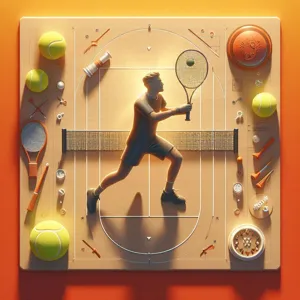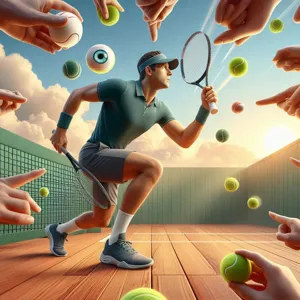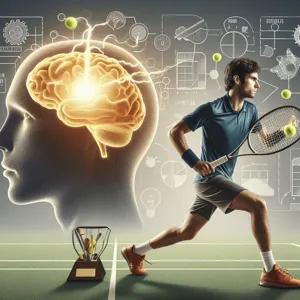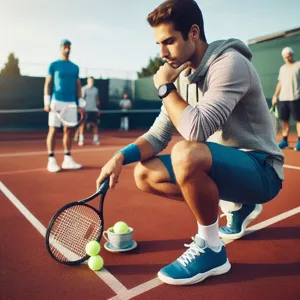Tennis, often hailed as a game of strategy as much as skill, requires players to cultivate a keen tactical awareness to outsmart their opponents on the court.
Whether you’re a seasoned player looking to refine your game or a beginner eager to rise through the ranks, understanding the nuances of court positioning, shot selection, and opponent analysis can dramatically elevate your performance. In this blog post, we’ll delve into the top strategies that can help you master the court, enabling you to anticipate plays, exploit weaknesses, and make split-second decisions that could turn the tide of a match in your favor. From honing your mental game to developing a strategic mindset, these insights will empower you to enhance your tactical awareness and ultimately, your overall game. Get ready to take your tennis skills to the next level and discover how a sharpened sense of strategy can lead you to victory!
1. Understanding Tactical Awareness in Tennis

Tactical awareness in tennis is more than just knowing how to hit the ball; it’s about developing a keen sense of the game that allows you to anticipate your opponent’s moves and make strategic decisions on the fly. It encompasses the ability to read the court, assess your opponent’s strengths and weaknesses, and adapt your playing style accordingly.
Think of tactical awareness as the chess component of tennis. Just as a chess player must foresee several moves ahead, a tennis player must constantly evaluate the trajectory of the match and adjust their tactics mid-game. This involves recognizing patterns in your opponent’s play—such as their favorite shots, tendencies under pressure, and preferred court positions. By understanding these elements, you can position yourself advantageously, choose the right shots, and exploit gaps in their strategy.
Moreover, tactical awareness goes hand in hand with mental fortitude. It requires staying calm under pressure and maintaining focus, even in the heat of a competitive match. The best players are those who can remain composed, quickly recalibrate their game plan, and execute with precision. This includes knowing when to play aggressively and when to adopt a more defensive posture, based on the dynamics of the match.
To build your tactical awareness, start by observing matches—both your own and those of experienced players. Note their decision-making processes, shot selections, and how they adapt to their opponents throughout the game. Engage in drills that challenge you to think critically and react swiftly. As you cultivate this skill set, you’ll find that your ability to read the game improves, leading to smarter plays and ultimately, better performance on the court.
2. The Importance of Court Positioning
Court positioning is one of the most fundamental yet often overlooked aspects of a successful tennis strategy. Your ability to effectively position yourself on the court can significantly influence the outcome of a match, allowing you to respond to your opponent’s shots with greater efficiency and confidence. Understanding where to stand in relation to the ball, your opponent, and the overall layout of the court is crucial for maximizing your tactical awareness.
Imagine this: you’ve just hit a deep forehand down the line, and your opponent scurries to intercept it. As they prepare to return, your next move should be calculated based on their positioning and the trajectory of the ball. Are you standing too close to the net, leaving yourself vulnerable to a lob? Or are you positioned too far back, making it difficult to execute an aggressive return? Striking the right balance is key.
A good rule of thumb is to aim for a dynamic court positioning strategy that adapts to the flow of the game. When on the offense, stepping inside the baseline can allow you to take control of the point, giving you the upper hand to dictate play. Conversely, when you’re on the defense, retreating deeper into your court can provide you with the necessary time to react to your opponent’s powerful shots, allowing for better shot selection.
Moreover, understanding the geometry of the court can enhance your overall awareness. Familiarizing yourself with angles and shot placement can guide you in positioning yourself to cover the most ground and anticipate your opponent’s next move. Employing drills that focus on court positioning can also sharpen your instincts; practicing footwork and movement patterns will create muscle memory, making it easier to react instinctively during a match.
In essence, mastering court positioning is not just about where you stand but about making strategic decisions that can turn the tide in your favor. By being mindful of your position relative to both the ball and your opponent, you’ll elevate your game and become a more formidable player on the court.
3. Analyzing Your Opponent’s Play Style

Understanding your opponent’s play style is a crucial aspect of enhancing your tactical awareness on the tennis court. Just as a chess player carefully studies their opponent’s moves, a successful tennis player must observe and analyze the patterns and strategies employed by their rival. This process begins long before the first serve is struck; it starts with keen observation and a strategic mindset.
As you warm up, take note of your opponent’s grip, their preferred shots, and how they respond to various types of balls. Are they more comfortable with forehands or backhands? Do they favor aggressive net play or a baseline game? Identifying these tendencies can provide invaluable insights into how to approach the match. For instance, if you notice they struggle with high balls, you might want to exploit that weakness by incorporating more topspin into your shots.
During the match, remain vigilant. Pay attention to their shot selection during critical points. Are they prone to playing it safe, or do they take risks? This can help you predict their next move and position yourself accordingly. If you notice a pattern—like consistently serving to your backhand—adjust your stance and prepare for their next shot to gain the upper hand.
Furthermore, consider the mental aspect of their game. Are they easily rattled by mistakes, or do they maintain composure under pressure? Understanding their psychological resilience can influence your strategy. If they seem nervous, applying consistent pressure might lead to unforced errors on their part. Conversely, if they thrive in high-stakes situations, it might be wise to play conservatively and wait for your opportunities.
Remember, analyzing your opponent’s play style isn’t just about countering their strengths; it’s also about leveraging their weaknesses. Embrace the challenge of adapting your game plan in real-time. By honing your ability to read your opponent, you’ll not only enhance your tactical awareness but also elevate your overall performance on the court.
4. Reading the Ball: Anticipation and Reaction
Reading the ball is a fundamental skill that separates the good players from the great ones in tennis. It’s not merely about hitting the ball; it’s about anticipating its trajectory, speed, and spin before it even leaves your opponent’s racket. Developing this ability will significantly enhance your tactical awareness, allowing you to position yourself optimally and make timely decisions during the match.
To improve your ball-reading skills, start by honing your focus during rallies. Pay close attention not only to the ball but also to your opponent’s body language and racket positioning. Subtle cues can tell you whether they’re preparing for a topspin forehand or a slice backhand, giving you a mental edge in positioning yourself for the next shot.
Practice drills that emphasize reaction time as well. Set up two cones on your side of the court and ask a partner to hit the ball to either side of the court. Your goal is to quickly react and move into position for each return, focusing on your footwork and balance. This not only enhances your anticipation skills but also builds muscle memory, enabling you to respond instinctively during a match.
Furthermore, incorporate visualization techniques into your training regimen. Spend a few minutes before each practice session or match picturing various scenarios: anticipate where shots will land, visualize your footwork, and imagine yourself executing the perfect return. This mental exercise can sharpen your awareness on the court, allowing for quicker reactions to your opponent’s plays.
Ultimately, mastering the art of reading the ball requires dedication and practice, but the rewards are immense. By developing this essential skill, you’ll find yourself more strategically positioned, better equipped to counter your opponent’s moves, and ultimately, more successful in your matches.
5. Developing a Strong Serve Strategy

A powerful serve is often the backbone of a successful tennis match, and developing a strong serve strategy can significantly enhance your tactical awareness on the court. The serve is not just a way to start the point; it’s an opportunity to assert your dominance and set the tone for the rally. To master this crucial aspect of your game, focus on three key elements: technique, placement, and variation.
**Technique**: Begin by ensuring your serving technique is sound. A solid stance, proper grip, and fluid motion are essential for generating both power and accuracy. Spend time practicing your toss—aim for consistency as it lays the foundation for a successful serve. Incorporate drills that focus on your serve mechanics, allowing you to build muscle memory and confidence. As you refine your technique, consider seeking feedback from a coach or using video analysis to identify areas for improvement.
**Placement**: Once you’ve mastered your technique, shift your focus to placement. A well-placed serve can disrupt your opponent’s rhythm and create openings for winning shots. Experiment with targeting different areas of the service box—serving wide to pull your opponent off the court can open up the opposite side for your next shot, while a down-the-middle serve may jam them, forcing a weak return. By strategically placing your serves, you can not only win points outright but also gain valuable information about your opponent’s weaknesses.
**Variation**: In tennis, predictability can be your worst enemy. To keep your opponent guessing, incorporate a variety of serves into your strategy. Mix in spin serves, flat serves, and kick serves, adjusting the speed and angle based on the situation. For instance, a kick serve can be particularly effective on clay courts, where the added bounce can throw off your opponent’s timing. By varying your serve, you will not only enhance your tactical awareness but also maintain the upper hand in your matches.
As you develop your serve strategy, remember that practice is key. Regularly incorporate serving drills into your training routine, and analyze your performance in matches to see what works best against different opponents. A strong serve strategy not only elevates your game but also boosts your confidence, allowing you to step onto the court with the assurance that you can dictate the pace of play right from the first point.
6. Effective Shot Selection: When to Attack and When to Defend
In the fast-paced world of tennis, knowing when to attack and when to defend can make the difference between winning and losing a match. Effective shot selection is not just about hitting the ball; it’s about understanding the dynamics of your opponent’s game, your own strengths, and the current state of the match.
When considering an offensive shot, evaluate your position on the court. Are you in an advantageous spot, with your opponent off-balance or out of position? If so, this is your moment to capitalize. A well-timed aggressive shot can force your opponent into a defensive stance, allowing you to take control of the rally. Look for opportunities to utilize your powerful forehand or a sharp cross-court shot that can catch them off guard.
Conversely, the ability to recognize when to defend is equally crucial. If your opponent is dictating the pace and hitting powerful shots, being overly aggressive could backfire. Instead, focus on maintaining consistency and retrieving the ball with precision. Play strategically by employing defensive techniques such as deep, high-lob shots or well-placed slices that can buy you time to regain your position and reset the rally.
Additionally, mix up your shots to keep your opponent guessing. A sudden drop shot followed by a deep baseline shot can disrupt their rhythm and create openings. The key is to remain flexible; a fluid mindset allows you to transition seamlessly between offensive and defensive play, adapting to the flow of the match as needed.
By mastering shot selection, you not only enhance your tactical awareness but also improve your overall performance on the court. Remember, tennis is as much a mental game as it is a physical one—being able to read the situation and make the right choices will elevate your play and keep your opponents on their toes.
7. Utilizing Deception in Your Game

Deception is a subtle yet powerful weapon in tennis, transforming the way you engage with your opponent and giving you a strategic edge on the court. When used effectively, deceptive plays can unsettle your rival, disrupt their rhythm, and create openings for you to exploit. Mastering this art requires not only skill but also a keen understanding of your opponent’s tendencies and weaknesses.
One of the most effective ways to incorporate deception into your game is through varied shot selection. By disguising your intentions, you can make your opponent second-guess their positioning. For instance, consider using a fake-out forehand followed by a quick drop shot. Your opponent, anticipating a deep rally, may find themselves caught off guard as they scramble to the net. Similarly, mixing up your serves can keep your rival on their toes; a well-placed slice serve can set up a powerful follow-up shot, leaving them scrambling to recover.
Another deceptive tactic involves body language. Your stance and swing can give away crucial information about your next move. By deliberately altering your posture or the speed of your preparation, you can mislead your opponent into misreading your shot. For example, a relaxed grip can signal a soft touch, while a tense stance might hint at a powerful drive. Learning to master this façade can turn the tide in crucial moments of the match.
Lastly, don’t underestimate the power of anticipation and reading your opponent’s cues. Observing their movements and habits can provide vital insights that enable you to counteract their strategies effectively. By understanding when they are likely to commit to a specific shot, you can use this knowledge to your advantage, setting up plays that exploit their predictable patterns.
Incorporating deception into your tennis strategy not only enhances your tactical awareness but also elevates the overall excitement of the game. As you refine these skills, you’ll not only keep your opponents guessing but also enjoy the thrill of outsmarting them with every point won.
8. The Role of Footwork in Tactical Awareness
Footwork is often described as the foundation of a successful tennis game, and for good reason. Mastering your footwork is not merely about moving quickly; it’s about moving intelligently. In the fast-paced environment of a tennis match, the ability to position yourself correctly in relation to the ball can significantly elevate your tactical awareness on the court.
When you have strong footwork, you gain the advantage of being able to anticipate your opponent’s shots more effectively. This anticipation allows you to make split-second decisions about where to direct your return. For instance, if you notice your opponent is consistently hitting to your backhand, good footwork enables you to adjust your positioning, giving you a greater chance to hit a powerful, accurate shot in response.
Moreover, proper footwork allows for smoother transitions between offensive and defensive play. When you’re well-positioned, you can quickly shift from a defensive stance to an aggressive one, catching your opponent off guard. This fluidity not only enhances your own game but also forces your rival to reconsider their tactics, giving you a psychological edge.
Incorporating footwork drills into your training routine can significantly improve your on-court performance. Simple exercises like ladder drills, cone sprints, and shadowing movements will enhance your agility and coordination. Additionally, practicing specific footwork patterns during match simulations will help reinforce your instincts, allowing you to react faster in real-game scenarios.
Ultimately, the role of footwork in tactical awareness cannot be overstated. It’s the key that unlocks your ability to read the game, adapt to your opponent’s strategies, and execute your own plays with precision. By focusing on your footwork, you’ll not only enhance your tactical awareness but also transform your overall game, turning you into a more formidable player on the court.
9. Practicing Situational Drills for Better Decision Making
Practicing situational drills is one of the most effective ways to enhance your tactical awareness on the tennis court. These drills simulate real match scenarios, allowing you to train your mind and body to respond instinctively to various situations. By incorporating specific game-like conditions into your practice sessions, you develop a deeper understanding of when and how to execute your shots, positioning, and strategies.
For instance, consider setting up drills that mimic specific match situations, such as being down 15-40 on your serve or facing a break point. By repeatedly encountering these situations in a controlled environment, you can refine your decision-making skills under pressure. Focus on the various options available to you: Should you go for a risky serve-and-volley tactic, or would it be wiser to play it safe with a reliable groundstroke? By analyzing your choices and their outcomes, you’ll start to recognize patterns and improve your ability to make quick, strategic decisions during real matches.
Additionally, practicing situational drills with a partner can add an extra layer of challenge and realism. This can involve alternating roles, where one player acts as the opponent, while the other responds based on the evolving scenario. This not only sharpens your tactical awareness but also enhances your adaptability to different playing styles and strategies.
Incorporating video analysis can further elevate your situational training. Record your drills and matches, then review the footage to assess your decision-making process. Look for moments where you made quick, effective choices or where hesitation led to missed opportunities. By identifying these key moments, you can target specific areas for improvement.
Ultimately, the goal of situational drills is to create muscle memory and mental clarity, so when you find yourself in a tense match situation, you can rely on your training to guide your actions. Through consistent practice, you’ll develop a sharper tactical awareness that will not only enhance your performance but also give you the confidence to execute your game plan under pressure. Keep practicing, and watch as your decision-making transforms, leading to smarter plays and more victories on the court!
10. Mental Toughness: Staying Focused Under Pressure
In the high-stakes world of tennis, where every match can swing on a single point, mental toughness becomes your greatest ally. Staying focused under pressure is not merely about maintaining concentration; it’s about developing a resilient mindset that allows you to thrive when the heat is on.
Imagine yourself in the fourth set of a closely contested match, the score tied, the crowd buzzing with anticipation. This is the moment that separates the champions from the rest. To cultivate mental toughness, begin by embracing the inevitable pressure that comes with competitive play. Recognize that everyone experiences anxiety, but what truly matters is how you channel that energy.
One effective technique is visualization. Before stepping onto the court, take a few moments to mentally rehearse your match scenario, picturing yourself executing successful serves, responding to difficult shots, and overcoming challenging moments. This mental imagery not only boosts your confidence but also prepares you for the unpredictable nature of live play.
Additionally, developing a routine can help ground you in the moment. Whether it’s bouncing the ball a specific number of times before your serve or taking a deep breath after every point, these rituals can provide a sense of control and calm amid the chaos of competition.
Another vital aspect of mental toughness is learning how to reset after a mistake. Tennis is a game of highs and lows, and the ability to quickly move past errors without letting them affect your performance is crucial. Practice positive self-talk and focus on the next point rather than dwelling on the past. Remember, the match isn’t over until the last point is played.
Lastly, embrace the challenge of pressure situations during practice. Simulate match scenarios where you must come back from behind or serve for the match. The more you expose yourself to high-pressure situations in training, the more comfortable and confident you’ll become when they arise in real matches.
By honing your mental toughness, you not only enhance your tactical awareness but also empower yourself to seize control of the game, turning pressure into a powerful tool for success on the court.
11. Watching and Learning from Professional Matches
One of the most effective ways to elevate your tactical awareness in tennis is by immersing yourself in professional matches. Watching elite players in action provides invaluable insights into the nuances of the game, from shot selection to court positioning. As you observe their strategies, take note of how they construct points, exploit their opponent’s weaknesses, and adapt their game in real-time to changing circumstances.
Focus on specific elements during each match. For instance, pay attention to how top players use angles to create openings, or how they anticipate their opponent’s moves. Notice the subtle body language they exhibit; their readiness to pivot or their focus during critical moments can teach you about mental resilience and tactical patience. Additionally, consider how they manage their court coverage, positioning themselves not just to return the ball, but to set up their next shot—this is a crucial aspect of tactical awareness that can significantly influence the outcome of any match.
Beyond just entertainment, analyzing professional matches serves as a form of active learning. You might even find it beneficial to watch matches with a friend or coach, discussing strategies and decisions made by the players as the game unfolds. This collaborative approach not only deepens your understanding but also reinforces your own tactical thinking. Incorporating what you learn into your practice routines will enhance your ability to read the game and execute strategies effectively, making you a more formidable competitor on the court. By consistently watching and learning from the best, you’ll sharpen your tactical awareness and develop a sharper edge in your game.
12. Keeping a Tactical Journal: Tracking Your Progress
Keeping a tactical journal is a powerful tool for any tennis player looking to enhance their strategic awareness on the court. Much like a diary for your tennis journey, a tactical journal allows you to document your thoughts, observations, and experiences following each match or practice session. This practice not only encourages self-reflection but also helps to identify patterns in your play, track your progress, and refine your tactics over time.
Start by dedicating a few minutes after each session to jot down key insights. Record the strategies that worked well for you, the shots that consistently failed, and the types of plays your opponents used against you. Note your emotional state during matches—were you feeling confident, anxious, or frustrated? Understanding your mental approach can significantly impact your game.
To make the most of your journal, consider creating specific sections for different aspects of your game. You might have separate pages for serving strategies, return of serve tactics, and court positioning. This organization will allow you to quickly reference your notes and identify trends over time.
As you review your entries, you may begin to see recurring themes or tactical gaps. Perhaps you recognize that you struggle with net play against aggressive opponents or that your backhand tends to falter under pressure. Armed with this information, you can tailor your practice sessions to address these weaknesses, turning them into strengths.
In addition to tracking your own performance, consider reviewing matches of professional players to compare their tactics with your own. Document how they handle similar scenarios and think critically about how you could apply those strategies to your game.
Ultimately, a tactical journal serves as a roadmap for your development in tennis. By consciously tracking your progress, you’ll not only enhance your tactical awareness but also build confidence in your decision-making on the court. Over time, this practice will empower you to play with greater intention and adaptability, leading to more successful outcomes in your matches.
13. Incorporating Video Analysis into Your Training
In the age of technology, incorporating video analysis into your tennis training can be a game-changer. This innovative approach allows players to gain invaluable insights into their performance by reviewing their matches and practice sessions through the lens of a camera. Whether you’re a beginner or an advanced player, this method can accelerate your tactical awareness and overall skill development.
Start by recording your practice sessions or matches, ensuring to capture various angles and viewpoints. Once you have your footage, take the time to analyze it. Look for patterns in your movements, shot selections, and responses to your opponent’s tactics. Are you consistently positioning yourself in the right spots? Do you tend to overcommit to certain shots? Video analysis can reveal these tendencies that might go unnoticed in the heat of play.
Beyond just self-analysis, sharing your footage with a coach or a more experienced player can provide additional perspectives. They can help identify strengths to build upon and weaknesses to address, offering targeted drills that cater to your unique playing style. By breaking down your game frame by frame, you can make more informed decisions about your training focus, leading to more effective practice sessions.
Moreover, watching matches of professional players can also enhance your tactical awareness. Analyze how they position themselves, their shot selection in various situations, and their responses to different playing styles. By comparing your game with theirs, you can adopt strategies that resonate with your style while also adapting your game to counter various opponents effectively.
Incorporating video analysis into your training not only helps improve your technical skills but also sharpens your tactical awareness, allowing you to visualize scenarios and make better decisions on the court. As you become more attuned to your gameplay and that of others, you’ll find yourself mastering the court with a heightened sense of strategy and confidence.
14. Communicating with Your Coach: Setting Tactical Goals
Effective communication with your coach is a cornerstone of developing tactical awareness in tennis. Setting clear tactical goals not only provides direction for your training but also fosters a collaborative relationship that can significantly enhance your performance on the court. Begin by discussing your strengths and weaknesses with your coach. This honest evaluation is crucial in identifying specific areas where you can improve your game strategy.
When you establish tactical goals, ensure they are SMART: Specific, Measurable, Achievable, Relevant, and Time-bound. For instance, if your coach notes that you struggle with defending against aggressive baseline players, you might set a goal to improve your defensive footwork by incorporating specific drills into your practice sessions. This could involve targeting a measurable improvement, such as successfully returning 80% of cross-court shots within four weeks.
Regular check-ins with your coach are essential to assess your progress toward these goals. This ongoing dialogue allows for adjustments to your training regimen as needed, ensuring that you remain focused and motivated. Additionally, your coach can help you analyze match footage and discuss tactical scenarios, reinforcing your understanding of when and how to implement various strategies during play.
Remember, the relationship with your coach is a partnership. Be open to feedback and proactive in seeking advice on tactical adjustments during matches. By clearly communicating your goals and maintaining an open line of dialogue, you will not only enhance your tactical awareness but also build a game plan that can adapt to any opponent you face on the court. This synergy between player and coach is invaluable in mastering the complexities of tennis strategy and ultimately achieving your competitive aspirations.
15. Conclusion: The Ongoing Journey of Mastering Tactical Awareness
In conclusion, mastering tactical awareness in tennis is not a destination but an ongoing journey that demands dedication, practice, and an open mind. Just as players continually refine their strokes and footwork, developing a keen sense of court awareness requires consistent effort and a willingness to learn from each match.
As you integrate the strategies discussed throughout this blog, remember that tactical awareness isn’t solely about anticipating your opponent’s next move; it’s also about understanding your own strengths and weaknesses, and how they can best be utilized in various match situations. Regularly analyzing your performance—whether through video review, reflective journaling, or discussions with coaches—will enhance your ability to read the game and adapt dynamically on the court.
Moreover, engaging in match play against a variety of opponents will expose you to different styles and strategies, sharpening your instincts and decision-making skills. Each match provides a valuable opportunity to test your tactical strategies and learn from the outcomes, whether they lead to victory or defeat.
Finally, embrace the mental aspect of the game. Visualization techniques and mindfulness can significantly improve your focus and composure, allowing you to remain present and make informed decisions under pressure.
As you strive to enhance your tactical awareness, remember that every player’s journey is unique. Celebrate your progress, stay curious, and keep pushing your limits. With perseverance and a commitment to continuous improvement, you’ll find yourself not just mastering the court, but also enjoying the beautiful complexities of this sport we love.
As we wrap up our exploration of tactical awareness in tennis, it’s clear that mastering the court requires more than just physical prowess; it demands a keen understanding of strategy and situational awareness. By implementing the top strategies we’ve discussed—from anticipating your opponent’s moves to utilizing effective positioning and shot selection—you’ll not only elevate your game but also enhance your overall enjoyment on the court. Remember, every match is an opportunity to learn and adapt, so embrace the challenges and celebrate your progress. With dedication and practice, you’ll find yourself not just playing tennis, but truly mastering it. Now, grab your racquet, hit the court, and put these strategies into action—your next victory awaits!




